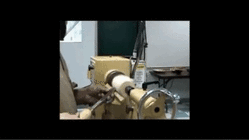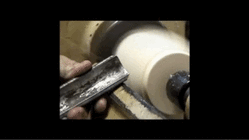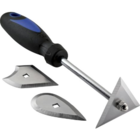Working through the process of making stave drums.
Have the blanks glued up and mounted.
I am a bowlturner, not a spindle turner. I like a bowl gouge and a scraper.
But It seems like turning drums is a lot more like spindle work than facework.
Here's where I'm at/
On the outside face:
I've tried a few carbide tools (flat and oval cutters) with mixed success.
Lots of tear out.
I've tried a bowl gouge. lots of tearout.
Recently I used a shear scrape cut (a la Bill Grumbine) with my tool handle low and that gave the best finish so far.
It works but its not optimum for removing a lot of wood
I was thinking - "Its a spindle, use a skew perhaps?
A spindle gouge?. I don't even know how to sharpen a spindle gouge.
Perhaps A roughing gouge first, then the shear scrape mentioned above.
Perhaps the tool rest needs to be higher than that for bowl turning.
The inside is still a work in progress.
I've had some success with a bowl gouge on a scraping cut with both wings resting on the wood.
We've also tried the Carter hollowing tool but that was a pretty lousy quality of cut.
The inside of the drums have to be a pretty decent quality finish.
I hate sanding so the better I get the finish from the tool, the happier I will be
THere's got to be some bettwer ways.
Any ideas or suggestions from stave/drum turners.
Thanks,
Have the blanks glued up and mounted.
I am a bowlturner, not a spindle turner. I like a bowl gouge and a scraper.
But It seems like turning drums is a lot more like spindle work than facework.
Here's where I'm at/
On the outside face:
I've tried a few carbide tools (flat and oval cutters) with mixed success.
Lots of tear out.
I've tried a bowl gouge. lots of tearout.
Recently I used a shear scrape cut (a la Bill Grumbine) with my tool handle low and that gave the best finish so far.
It works but its not optimum for removing a lot of wood
I was thinking - "Its a spindle, use a skew perhaps?
A spindle gouge?. I don't even know how to sharpen a spindle gouge.
Perhaps A roughing gouge first, then the shear scrape mentioned above.
Perhaps the tool rest needs to be higher than that for bowl turning.
The inside is still a work in progress.
I've had some success with a bowl gouge on a scraping cut with both wings resting on the wood.
We've also tried the Carter hollowing tool but that was a pretty lousy quality of cut.
The inside of the drums have to be a pretty decent quality finish.
I hate sanding so the better I get the finish from the tool, the happier I will be
THere's got to be some bettwer ways.
Any ideas or suggestions from stave/drum turners.
Thanks,



